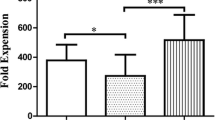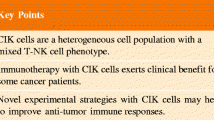Summary
Interferons consistently enhance spontaneous cellular cytotoxicity (SCC) mediated by natural killer (NK) cells. More controversial is the ability of interferons to enhance antibody-dependent cellular cytotoxicity (ADCC) mediated by killer (K) cells. Since NK and K cells appear to represent overlapping subpopulations of lymphocytes, the present study was undertaken to examine in greater detail the relationship between NK and K cell functional modulation by the potent interferon inducer, poly I:C. Utilizing peripheral mononuclear cells from a panel of 21 healthy individuals, treatment in vitro with poly I:C resulted in modulation of both SCC and ADCC. SCC was significantly enhanced in 52 of a series of 55 trials (95%), whereas ADCC was significantly enhanced in parallel in only 18 of the trials (33%). Cells which mediated enhanced ADCC were plastic-nonadherent, which is characteristic of K cells. SCC was consistently enhanced in all but two of the 14 individuals who were tested two or more times. By contrast, the ability of poly I:C to enhance ADCC varied between trials in 11 of these individuals. In the other three, ADCC enhancement never occurred. No correlation existed between SCC and ADCC augmentation despite use of the same target cell to assess the two lytic activities in parallel. Poly I:C exclusively enhanced SCC in 36 trials (65%) and exclusively enhanced ADCC in two trials (4%). Discordance between SCC and ADCC enhancement also occurred in three of eight trials (38%) in which lymphocytes were treated directly with interferon a. Results in long-term (18-h) 51Cr-release assays indicated that poly I:C accelerated the kinetics of ADCC without affecting the proportion of target cells lysed by K cells. By contrast, an increased proportion of target cells was killed by poly I:C-stimulated NK cells. These results suggest that the controversy concerning relative interferon effects upon NK and K cells derives from differences both quantitative and qualitative in nature. K cell activity is enhanced but at a relatively low frequency. Enhancement of NK cell activity is selective in the sense that it occurs independently of and with greater frequency than enhancement of K cell activity. Distinct biological mechanisms may, therefore, be involved in regulation and expression of NK and K cell activation by interferons.
Similar content being viewed by others
References
Borden EC, Hawkins MJ, Edwards BS, Liberati AM, Cantell K (1982) Pharmacologic and immunologic effects of human leukocyte interferon in patients with neoplasia: an interim report. Proceedings Conference on Clinical Potentials of Interferons in Viral Disease and Malignant Tumors. In: Kono R (ed.), Japan Medical Research Foundation, Tokyo, p. 169
Cantell K, Hirvonen S, Morensen KE, Phyälä L (1973) Human leukocyte interferon: production, purification, stability, and animal experiments in the production and use of interferon for the treatment and prevention of human virus infections. Proc Tissue Culture Assoc Workshop. In vitro Monogr 3:35
DeLandazuri MO, Silva A, Alvarez J, Herberman RB (1979) Evidence that natural cytotoxicity and antibody-dependent cellular cytotoxicity are mediated in humans by the same effector cell populations. J Immunol 123:252
DeVries JE, Mendelsohn J, Bont WS (1980) The role of target cells, monocytes, and Fc receptor-bearing lymphocytes in human spontaneous cell-mediated cytotoxicity and antibody-dependent cellular cytotoxicity. J Immunol 125:396
Droller MJ, Borg H, Perlmann P (1979) In vitro enhancement of natural and antibody-dependent lymphocyte-mediated cytotoxicity against tumor target cells by interferon. Cell Immunol 47:248
Fast LD, Hansen JA, Newman W (1981) Evidence for T cell nature and heterogeneity within natural killer (NK) and antibody-dependent cellular cytotoxicity (ADCC) effectors: a comparison with cytolytic T lymphocytes (CTL). J Immunol 127:448
Herberman RB, Ortaldo JR (1981) Natural killer cells: their role in defenses against disease. Science 214:24
Hokland P, Berg K (1981) Interferon enhances antibody-dependent cellular cytotoxicity (ADCC) of human polymorphonuclear leukocytes. J Immunol 127:1585
Jensen PJ, Koren HS (1980) Heterogeneity within the population of NK and K cells. J Immunol 124:395
Kay HD, Horowitz DA (1980) Evidence by reactivity with hybridoma antibodies for a probable myeloid origin of peripheral blood cells active in natural cytotoxicity and antibody-dependent cell-mediated cytotoxicity. J Clin Invest 66:847
Kay HD, Bonnard GD, West WH, Herberman RB (1977) A functional comparison of human Fc-receptor-bearing lymphocytes active in natural cytotoxicity and antibody-dependent cellular cytotoxicity. J Immunol 118:2058
Kimber I, Moore M (1981) Selective enhancement of human mononuclear leucocyte cytotoxic function by interferon. Scand J Immunol 13:375
Klein M, Roder J, Haliotis T, Korec S, Jett JR, Herberman RB, Katz P, Fauci AS (1980) Chediak-Higashi gene in humans. II. The selectivity of the defect in natural killer and antibody-dependent cell-mediated cytotoxicity function. J Exp Med 151:1049
Mantovani A, Allavena P, Sessa C, Bolis G, Mangioni C (1980) Natural killer cell activity of lymphoid cells from human ascitic ovarian tumors. Int J Cancer 25:573
Mantovani A, Allavena P, Introna M, Biondi A, Sessa C, Mangioni C (1981) Cytolytic activity against fresh tumor cells of peripheral blood lymphocytes (PBL) and tumor-associated lymphoid cells (TAL) in human ovarian carcinoma: stimulation by interferon. Proc Am Assoc Cancer Res 22:291
Nair MPN, Schwartz SA (1981) Suppression of natural killer activity and antibody-dependent cellular cytotoxicity by cultured human lymphocytes. J Immunol 126:2221
Neville ME (1980) Human killer cells and natural killer cells: Distinct subpopulations of Fc receptor-bearing lymphocytes. J Immunol 125:2604
Ortaldo JR, Pestka S, Slease RB, Rubinstein M, Herberman RB (1980) Augmentation of human K-cell activity with interferon. Scand J Immunol 12:365
Parrillo JE, Fauci AS (1978) Comparison of the effector cells in human spontaneous cellular cytotoxicity and antibody-dependent cellular cytotoxicity: Differential sensitivity of effector cells to in vivo and in vitro corticosteroids. Scand J Immunol 8:99
Perussia B, Trinchieri G, Cerottini JC (1979) Functional studies of Fc receptor-bearing human lymphocytes: effect of treatment with proteolytic enzymes. J Immunol 123:681
Reynolds CW, Brunda MJ, Holden HT, Herberman RB (1981) Role of macrophages in in vitro augmentation of rat, mouse, and human natural killer activities. J Natl Cancer Inst 66:837
Saksela E, Timonen T, Cantell K (1979) Human natural killer cell activity is augmented by interferon via recruitment of ‘pre NK’ cells. Scand J Immunol 10:257
Seaman WE, Merigan TC, Talal N (1979) Natural killing in estrogen-treated mice responds poorly to poly I:C despite normal stimulation of circulating interferon. J Immunol 123:2903
Shore SL, Melewicz FM, Gordon DS (1977) The mononuclear cell in human blood which mediates antibody-dependent cellular cytotoxicity to virus infected target cells. I. Identification of the population of effector cells. J Immunol 118:558
Targan S, Dorey F (1980) Interferon activation of “pre-spontaneous killer” (pre-SK) cells and alteration in kinetics of lysis of both “pre-SK” and active SK cells. J Immunol 124:2157
Trinchieri G, Santoli D, Koprowski H (1978) Spontaneous cell-mediated cytotoxicity in humans: role of interferon and immunoglobulins. J Immunol 120:1849
Tucker SB, Pierre RV, Jordan RE (1977) Rapid identification of monocytes in a mixed mononuclear cell preparation. J Immunol Methods 14:267
Vanky FT, Argov SA, Einhorn SA, Klein E (1980) Role of alloantigens in natural killing. Allogeneic but not autologous tumor biopsy cells are sensitive for interferon-induced cytotoxicity of human blood lymphocytes. J Exp Med 151:1151
Zarling JM, Eskra L, Borden EC, Horoszewicz J, Carter WA (1979) Activation of human natural killer cells cytotoxic for human leukemia cells by purified interferon. J Immunol 123:63
Zarling JM, Schlais J, Eskra L, Greene J, Ts'o POP, Carter WA (1980) Augmentation of human natural killer cell activity by polyinosinic acid-polycytidylic acid and its non-toxic mismatched analogues. J Immunol 124:1852
Author information
Authors and Affiliations
Rights and permissions
About this article
Cite this article
Edwards, B.S., Borden, E.C. & Smith-Zaremba, K. Divergence in activation by poly I:C of human natural killer and killer cells. Cancer Immunol Immunother 13, 158–163 (1982). https://doi.org/10.1007/BF00205381
Received:
Accepted:
Issue Date:
DOI: https://doi.org/10.1007/BF00205381




